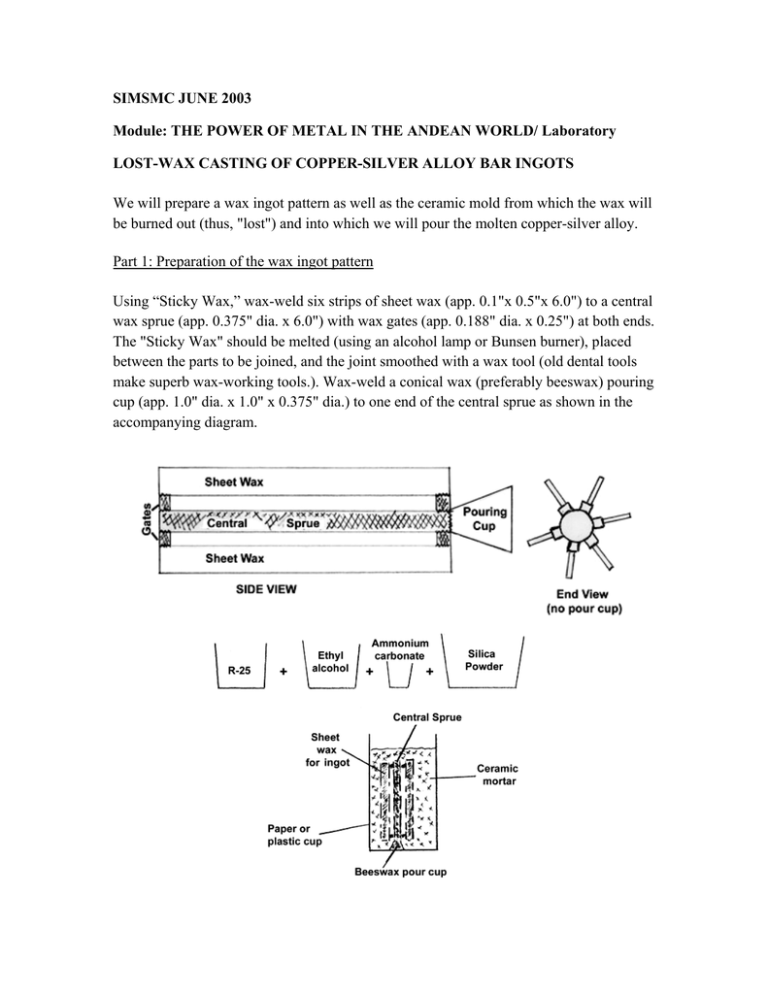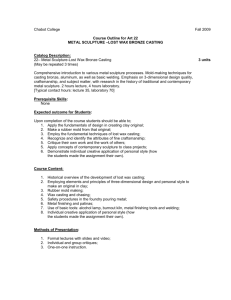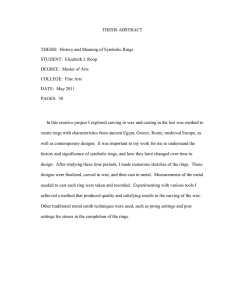SIMSMC JUNE 2003 LOST-WAX CASTING OF COPPER-SILVER ALLOY BAR INGOTS
advertisement

SIMSMC JUNE 2003 Module: THE POWER OF METAL IN THE ANDEAN WORLD/ Laboratory LOST-WAX CASTING OF COPPER-SILVER ALLOY BAR INGOTS We will prepare a wax ingot pattern as well as the ceramic mold from which the wax will be burned out (thus, "lost") and into which we will pour the molten copper-silver alloy. Part 1: Preparation of the wax ingot pattern Using “Sticky Wax,” wax-weld six strips of sheet wax (app. 0.1"x 0.5"x 6.0") to a central wax sprue (app. 0.375" dia. x 6.0") with wax gates (app. 0.188" dia. x 0.25") at both ends. The "Sticky Wax" should be melted (using an alcohol lamp or Bunsen burner), placed between the parts to be joined, and the joint smoothed with a wax tool (old dental tools make superb wax-working tools.). Wax-weld a conical wax (preferably beeswax) pouring cup (app. 1.0" dia. x 1.0" x 0.375" dia.) to one end of the central sprue as shown in the accompanying diagram. Part 2: Preparation of the mold The large end of the pouring cup on the newly made wax "tree" should be wax-welded into a cylindrical container whose inside diameter and length are approximately 0.5" greater than those of the completed "tree" (see accompanying diagram). Appropriately sized mailer tubes or paper or plastic drink cups all are suitable choices. The ceramic investment material consists of fine silica powder bonded with R-25 concentrated ethyl silicate (silicon dioxide and ethyl alcohol) which is further reduced with ethyl alcohol and catalyzed by an aqueous solution of ammonium carbonate. Measure out enough silica powder to fill the cylindrical container and carefully weigh the powder, since all the following calculations are based on this initial weight. The binder weight (20% of the powder wgt) consists of three wgt parts binder concentrate and two wgt parts ethyl alcohol (200 proof). The liquid catalyst weight (3 g ammonium carbonate powder in 97 g distilled water) is 6% of the binder weight. EXAMPLE: Silica powder -100 g Binder -20 g (R-25 -12 g; ethyl alcohol -8 g) Liquid Catalyst -1.2 g After carefully weighing all components, add the ethyl alcohol to the R-25 concentrate; add the liquid catalyst to the R-25/ethyl alcohol mix; stir this thoroughly and add it to the dry silica powder in a suitable mixing container. All components should be quickly (you'll have about ten minutes, maximum) and completely blended into a smooth mortar (if done correctly, about the consistency of cake batter) and carefully poured around the wax "tree" into the cylindrical container. Make certain that the level of ceramic is at least 0.5" above the uppermost bit of wax (see diagram on following page). This mix should remain undisturbed until it solidifies (about one hour, depending upon size of mold, ambient temperature, and relative humidity). Part 3: Wax burnout Carefully remove the paper/plastic container from the solidified ceramic mold. Place the mold on a grill or grate, preferably suspended over a container of water that is out of doors or under a high temperature exhaust hood. The end of the mold that contains the pouring cup should face down. Light the mold with a match and allow the alcohol to burn off and most of the wax to melt out. The water prevents the accumulating pool of wax from igniting. Once the flame has completely subsided, the mold should be placed inside a vented box furnace, brought to 1500 degrees Fahrenheit, and held at that temperature for at least one hour. Part 4: Metal casting Once the ceramic mold has been fired as described above, it can be removed from the furnace, safely supported in a base of sand, and filled with molten metal immediately. It is also acceptable to let the mold cool and pour the metal into a room-temperature mold at a later date, provided that the mold has been kept absolutely dry in the interim. As soon as the poured metal "tree" has solidified, it can be removed from the ceramic mold simply by chipping/rubbing away the now weak ceramic material surrounding it. Cooling for safe handling can be hastened by putting the mold under running water as necessary. This also reduces dust production during removal of the metal casting. Part 5: Separation of ingots from the sprue After removing all ceramic residue from the metal "tree" (stubborn bits can be removed with the aid of wire brushes, steel wool, and copious amounts of water), cut away the six individual ingots from the central sprue. Use a hacksaw or a grinder (die or right angle) equipped with an abrasive cut-off wheel designed for non-ferrous metals. The sprue should be securely held in a vise or clamp and each gate cut as close to the attached ingot surface as possible. Once removed and cleaned, the ingot is ready to be worked, cold or hot. SAFETY!!!SAFETY!!!SAFETY!!! SAFETY!!! SAFETY!!! SAFETY!!! SAFETY!!! EYES: Safety glasses with attached side shields are a MUST from start to finish. No exceptions, no excuses, no substitutions. Hot wax, broken tool blades, alcohol, ceramic powder, adhesive/abrasive dust, and metal filings all qualify as materials you don't want in your eyes. EARS: Wear hearing protection as necessary. Most grinders operate at harmful noise levels. LUNGS: Wear a dust mask and/or respirator and work with plenty of ventilation, i.e. either with a high-temperature exhaust hood or out of doors. Prolonged exposure to silica powder, wax fumes, alcohol fumes, ammonia fumes, adhesive/abrasive dust, and metal dust can cause various immediate and/or long-term health problems. SKIN: Wear gloves, lab coats (or long-sleeved shirts and long pants), closed shoes, and flame- retardant/flame-repellent apparel as necessary. Minute sharp particles of silica can enter the bloodstream through open wounds, hot wax and hot metal can cause severe burns, and sharp metal edges can cause cuts and scrapes. FIRE AND EXPLOSION HAZARDS: Know what metals/alloys you are melting. Some (e.g. magnesium) are quite volatile when they reach the melting point in an air atmosphere. Keep all combustibles away from the casting area and have appropriate fire extinguishers handy. If moisture comes into contact with molten metal, it will certainly and immediately become steam, expanding 1600/1. Moisture (be it wax or water) left inside the ceramic mold will become steam that will shatter the mold if molten metal is poured into it. Moreover, damp or merely cold tools or pieces of metal introduced to an already molten charge in a crucible can precipitate an explosion when the resultant condensation turns to steam.







